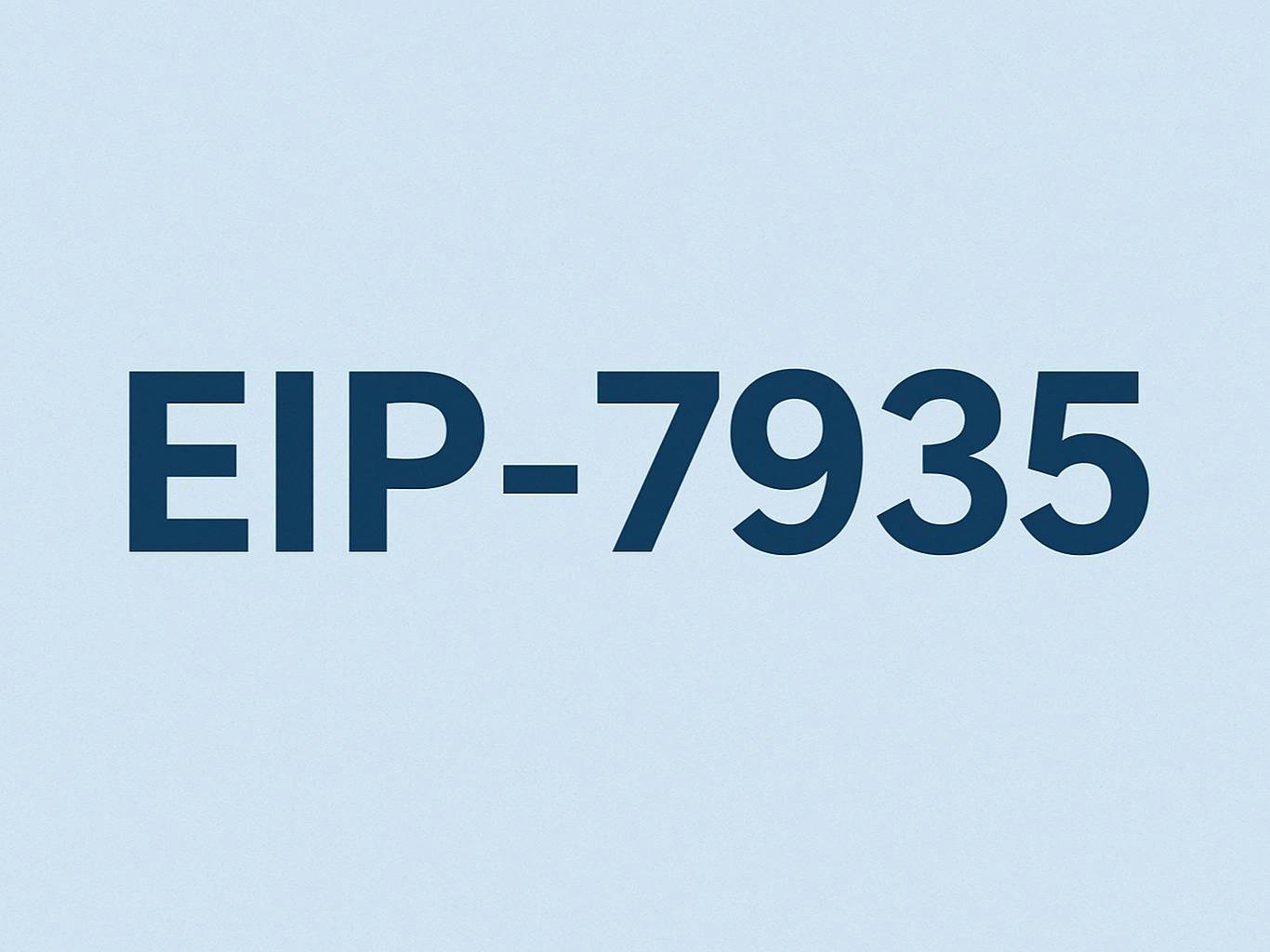订阅 wiki
Share wiki
Bookmark
EIP-7935
EIP-7935
EIP-7935 是一项信息性的以太坊改进提案,创建于 2025 年 4 月 22 日,建议协调增加以太坊主网的默认区块 gas 限制。该提案明确将限制从 3600 万提高到 6000 万。此更改不是共识规则的修改,而是对执行层客户端的默认软件配置的更新,旨在与 Fusaka 网络升级结合实施。EIP-7935 的主要目标是扩展以太坊基础层的执行能力,允许更大的交易吞吐量,并正式确定在更高计算负载下运行网络的测试过程。[1] [2]
概述和动机
EIP-7935 代表了对以太坊链上容量的一项战略调整。作为一项“信息性” EIP,其实现依赖于社会共识和客户端开发团队之间的协调,而不是直接改变以太坊协议的共识规则。该提案呼吁执行层 (EL) 客户端(处理交易和管理以太坊状态的软件)的开发者将其软件中的默认 GAS_LIMIT 参数从 3600 万更改为 6000 万。 [2]
此次增加的主要动机是提高 Layer 1 (L1) 的执行可扩展性。区块 gas limit 充当单个区块中可以包含的总计算工作量(以 gas 衡量)的上限。通过提高此限制,每个区块可以容纳更多交易或更多计算密集型智能合约交互,从而提高网络的整体交易吞吐量。 [3] [2]
该提案是在以太坊社区内关于其长期扩展战略的更广泛辩论中提出的。以太坊的官方“rollup 中心路线图”优先考虑 Layer 2 (L2) 扩展解决方案,例如 Optimistic 和 ZK-rollups,以处理大部分交易处理。在此模型下,主网的主要作用转变为数据可用性和安全性,充当 L2 的结算层。虽然此策略有效,但一些批评者认为,过度依赖 L2 可能会导致流动性分散、用户体验复杂以及潜在的中心化风险,因为许多 rollup 在早期阶段使用中心化排序器来对交易进行排序。 [4]
EIP-7935 的支持者认为,适度增加 L1 gas limit 是一种直接而简单的方式来提高原生吞吐量,使基础层能够更好地处理需求并与其他高吞吐量区块链保持竞争力。此更改不被视为 rollup 中心路线图的替代方案,而是作为一种补充增强。该提案的提出正值 2025 年初,当时网络 gas 费用相对较低,部分原因是 EIP-4844 (Proto-Danksharding) 的成功实施,该提案大大降低了 L2 的数据发布成本,并将用户活动转移到这些网络。L1 区块空间需求较低的这段时间为考虑和测试 gas limit 增加提供了一个绝佳的机会。 [4]
提案详情
规范
EIP-7935 的技术核心是对以太坊执行层客户端软件中的单个配置值的更改。它没有引入新的协议特性,而是利用了现有的机制。 [2]
虽然最终提案的目标是 6000 万 gas 限制,但 2025 年 4 月的初步讨论和早期报告引用了一个更激进的目标,即 1.5 亿。这个更高的数字是围绕提案引入的早期讨论的一部分,但官方 EIP 后来被标准化为 6000 万的限制,以确保更安全、更渐进的增加。 [4] [3]
采用 EIP 流程的理由
尽管 EIP-7935 是一个软件配置更改,而不是共识规则,但其作者选择使用正式的 以太坊改进提案 流程。从历史上看,协调所有客户端团队的 gas limit 更改一直具有挑战性。EIP 框架提供了一个结构化和透明的流程,将开发者资源投入到这项任务中。 [2]
通过形式化更改,该提案确保所有执行层客户端团队(如 Geth、Nethermind、Besu 和 Erigon)将投入时间进行严格测试,识别和修复当网络以更高容量运行时可能出现的任何潜在错误或性能瓶颈。将实施与 Fusaka 硬分叉联系起来,创建了一个清晰的时间表,并促进了强大的社会共识,使得所有客户端同时采用新默认值的可能性很高,从而确保了平稳的网络范围过渡。 [2]
历史与发展
创建和时间线
EIP-7935于2025年4月22日正式创建并发布。它由一群著名的以太坊研究人员和开发者通过在官方以太坊 EIPs GitHub存储库上的pull request引入,标志着正式社区审查的开始。 [2] [[4]](#cite-id-EyrOJeuFVGIS5R9r]
该提案经历了EIP标准化过程,并进入“最后征求意见”状态,社区反馈和评论的最终截止日期设定为2025年10月28日。在此期间之后,EIP被确认包含在即将到来的Fusaka硬分叉中。 [2]
作者
该提案由来自各个以太坊客户端和研究团队的多学科贡献者小组撰写,表明该倡议获得了广泛支持。列出的作者是:
- Sophia Gold (@sophia-gold)
- Parithosh Jayanthi (@parithoshj)
- Toni Wahrstätter (@nerolation)
- Carl Beekhuizen (@CarlBeek)
- Ansgar Dietrichs (@adietrichs)
- Dankrad Feist (@dankrad)
- Alex Stokes (@ralexstokes)
- Josh Rudolph (@jrudolph)
- Giulio Rebuffo (@Giulio2002)
- Storm Slivkoff (@sslivkoff)
- Kamil Chodoła (@kamilchodola) [2]
Gas Limit 变更的背景
以太坊上的 gas limit 自网络成立以来已经发生了显著的变化,反映了扩展区块链的持续努力。
- 2015年: 在其启动时,gas limit 大约是 5,000 gas。
- 2021年: 该限制已增长到大约 1500 万 gas。
- 2022年: 在“合并”之后,以太坊 过渡到 权益证明 共识机制,该限制稳定在接近 3000 万 gas。
- 2025年初: 在 EIP-7935 提案之前,该限制从 3000 万增加到 3600 万 gas。
EIP-7935 中提出的增加到 6000 万代表了这一长期以来逐步增强容量的又一步。 [4] [3]
在Fusaka升级中的实施
EIP-7935计划作为Fusaka网络升级的一部分实施。硬分叉计划于2025年12月3日UTC时间21:49:11进行。在此升级的上下文中,EIP-7935被归类为“次要提案”,因为它涉及配置更改,而不是协议的根本性改变。它与其他更复杂的提案(如EIP-7594 (PeerDAS) 和 EIP-7951)一起打包,这些提案是Fusaka升级的主要特性。 [1]
安全性和兼容性
测试和发布计划
EIP-7935 流程的核心组成部分是其全面的测试计划,旨在确保在新的、更高的 gas 燃料限制下网络的稳定性和性能。EIP 的作者概述了一个多阶段流程来降低部署风险。该计划包括:
- 开发网络测试: 创建专门的开发网络 (devnet),运行各种执行层 (EL) 和共识层 (CL) 客户端的组合,以测试互操作性。
- 压力测试: 这些开发网络接受了持续的压力测试,其中区块被合成地填充到其 6000 万 gas 的最大容量。此过程旨在揭示客户端软件中的性能下降、内存泄漏或其他潜在错误。
- 网络监控: 在整个测试阶段,密切监控节点和网络健康指标,以识别任何不利影响。
- 迭代发布: 该计划规定,如果没有发现重大问题,gas 限制将继续进行。但是,如果发现重大错误,客户端团队将开发补丁,并重复测试周期。 [2]
区块大小和网络健康
对于任何 gas 上限的增加,一个关键的安全考虑因素是其对区块大小的影响,以及对网络点对点 gossip 层的相应压力。更大的区块可能需要更长的时间来传播,可能导致孤块增加和网络稳定性降低。
EIP-7935 的作者引用了先前对对抗性区块构造的研究——专门设计成在给定的 gas 上限下尽可能大和资源密集的区块。该分析得出结论,6000 万 gas 上限完全在安全范围内。据估计,即使在这种限制下的最坏情况区块也不会产生超过共识层对区块的 10 MiB gossip 限制的区块大小。作者指出,区块大小可能成为严重网络问题的“危险区域”估计接近 1.5 亿 gas 上限。在 EIP 编写时,主网上观察到的最大区块为 1.79 MiB,表明有很大的提升空间。 [2]
向后兼容性
EIP-7935旨在完全向后兼容,这意味着它预计不会破坏任何现有的智能合约或去中心化应用程序。但是,EIP的作者确实注意到与另一个假设的EIP可能存在冲突,该EIP可能会引入每次交易的gas限制(例如,单笔交易的gas上限为3000万)。如果未来实施这样的EIP,6000万的区块gas限制将允许一个区块包含超过此单笔交易限制的交易。作者表示,在未来的升级中,需要仔细协调这两种EIP的调度和规范。 [2]
相关提案
围绕 EIP-7935 的讨论是以太坊 L1 扩展的更广泛对话的一部分。另一项更激进的提案 EIP-9698 也由 EIP-7935 的合著者 Dankrad Feist 在 2025 年提出。
EIP-9698,题为“指数 Gas 限制增长”,提出了一个确定性的时间表,在四年内将 gas 限制提高 100 倍。该机制包括每 164,250 个 epoch(大约两年)增加十倍,这将使限制从 3600 万提高到 36 亿。在这样的限制下,以太坊 基础层理论上可以处理每秒高达 2,000 笔交易。这项影响深远的计划的支持者认为,可预测的、渐进的增长将使生态系统有足够的时间来调整节点硬件和软件。虽然 EIP-7935 代表了一个保守的、近期的步骤,但 EIP-9698 说明了在正在进行的关于 L1 容量的辩论中,雄心的上限。 [4]
发现错误了吗?
